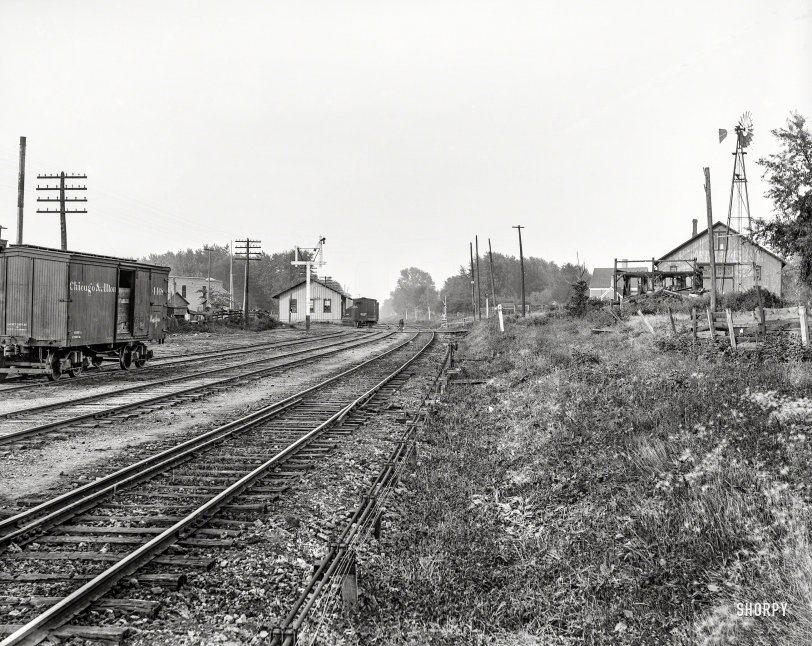


Framed or unframed, desk size to sofa size, printed by us in Arizona and Alabama since 2007. Explore now.
Shorpy is funded by you. Patreon contributors get an ad-free experience.
Learn more.

- Baldwin 62303
- Baldwin VO-1000
- Cold
- No expense spared
- Tough Guys
- Lost in Toyland
- And without gloves
- If I were a blindfolded time traveler
- Smoke Consumer Also Cooks
- Oh that stove!
- Possibly still there?
- What?!?
- $100 Reward
- Freeze Frame
- Texas Flyer wanted
- Just a Year Too Soon
- WWII -- Replacing men with women at the railroad crossing.
- Yes, Icing
- You kids drive me nuts!
- NOT An Easy Job
- I wonder
- Just add window boxes
- Icing Platform?
- Indiana Harbor Belt abides
- Freezing haze
- Corrections (for those who care)
- C&NW at Nelson
- Fallen Flags
- A dangerous job made worse
- Water Stop
Print Emporium
Near Normal: 1900

Circa 1900. "Track to be straightened. Normal, Ill's." 8x10 inch dry plate glass negative, Detroit Photographic Company. View full size.
If it wasn't labeled "Normal [Ill.]
I might have placed the scene in Peculiar, Mo.
Arch bar trucks
Arch bar trucks were legal on interchange railroads until 1940, but they had been being phased out for decades before that.
They were used a lot longer than that on non-interchange lines like the SP narrow gauge -- one of the boxcars in our collection (SP 10) was still in service on the Inyo-Kern SP in 1960. Southern Pacific Boxcar 10 Repack Date This wooden Carter built boxcar was originally built in 1880. It is still sitting on trucks on our track in Fremont, CA. It could be one of the longest 'in service' box cars in the world--hard to say though.
Air Brakes
The car in the background by the platform does have air brakes, as evidenced by the presence of a brake hose dangling to the right of the coupler. The car in the left foreground does not appear to have air brakes.
The air brake in its present form was introduce in 1869, but there was no requirement that they be installed on all cars. Cars without air brake equipment were run at the rear of the train so that the cars with the equipment could be strung together at the front of the train under the control of the engineer. If the engineer needed more braking force than could be provided the equipped cars alone, whistle signals advised the conductor and rear trainman to walk to the top of the train setting handbrakes.
The type of control valves in use by 1900 were only reliable for trains up to about 20 cars, so frequently longer trains were run with the air hoses connected on only the front portion of the train and the remainder of the train was still controlled by handbrakes as described above. These were called "part air" trains.
Improvements to brake valves introduced in 1906 allowed longer trains, with up to 40 cars controlled by air brakes. The type AB brake valve on cars, introduced in 1933, permitted reliable control of a train with air of up to 150 cars, and part air trains disappeared shortly after that.
Straightening
The straightening spoken of is probably just that. The curvature may be too severe for the escalating speeds that railroads were beginning to see. Realigning was sometimes done to gain grade improvements as well. The derail probably remained if cars were still left on that track if they could endanger the main line.
Interesting scene.
Archbar trucks were legal for many years after this photo. Interesting details here: note the grain door in the boxcar at left; also the point derail in foreground and dwarf signal operated by pipe rodding from a tower behind the photographer.
Another detail is the home signal on the gantry ... it is two-position with only red and white colors, which was standard on most railroads until a few years later. The signal is operated with long wires, which you can see alongside the pipe rodding in foreground.
Interesting bit of trackwork
There is a derail built into the rail closest to the viewer. It is controlled by the rods along side the track. Its purpose was to prevent runaway cars from fouling the main line. Seldom seen in the modern era.
Rail to be straightened.
The rail to be straightened reference you mentioned is a derail and is controlled by rodwork from either a tower in back of the photographer or the depot building.
Location
Mile post C124, must be 124 miles to Chicago, Ill.
Archbar trucks and brakewheels
Definitely a transition era-- the wooden box cars have archbar trucks with wooden bolsters; journal boxes with babbit metal bearings; body hung brakes with no signs of airbrakes, but they have Janney knuckle couplers.
Can you image being a brakeman on these boxcars? Having to run on the roofwalk and jump between cars to turn the brakewheels to stop or slow these cars. yikes.
Old Cars
I know steam locomotives, not cars, but these seem a bit outdated even for 1900. They look at best 1880's vintage, though they've obviously been well maintained. This is along the Chicago & Alton route between Chicago and St. Louis.
























On Shorpy:
Today’s Top 5